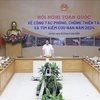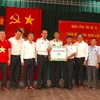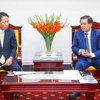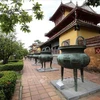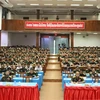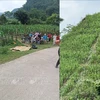Twice a week, Yoko Kamiharako takes a taxi to a small calligraphy class in Ho Chi Minh City’s Binh Thanh district from her residence in District 1.
She wants to gain proficiency in Vietnamese calligraphy under the tutelage of young calligrapher Duong Minh Hoang.
In seven months, forty-year-old Yoko has become a special student at the class though she speaks very little Vietnamese and English, barely enough to communicate with her classmates and understand what her teacher says.
However, having trained in Japanese calligraphy and taught the art to others for more than 15 years, she decided to invest her free time in learning to write Vietnamese letters. She found Hoang's website while surfing the web.
But there was an added motivation as well: "I have been learning Vietnamese at Ho Chi Minh City University of Social Sciences and Humanity, and I find that learning Vietnamese calligraphy is a way to improve my Vietnamese skills."
New to the environment and culture in Vietnam, she felt learning the local language and art was one of the ways to overcome language and other barriers. She recalled that during the first days living in Ho Chi Minh City, she could only go to Ben Thanh Market, where she could speak in her halting English with shopkeepers.
"I see that there are big differences between Vietnamese and Japanese calligraphy. It is not easy to train in Vietnamese calligraphy, and likewise, it is particularly hard for a foreigner like me to adapt to the environment in Vietnam.
"But learning calligraphy is one of the ways in which I am trying to adapt to my life here, because the decision for my husband to come here was sudden. I did not have enough time to prepare for it," she said.
Yoko has also opened a class teaching Japanese calligraphy at her house in Somerset Residence. In Japan, she worked for a calligraphy company, so it's not difficult for her to instruct other people.
She is hoping to become skillful enough to compose Vietnamese calligraphy and have it exhibited here along with her work in her original language.
According to Hoang, language was indeed an initial barrier in teaching Yoko, but she has learnt very fast, partly because she is a teacher of Japanese calligraphy.
"I think Yoko loves writing in Vietnamese, comparing it with Japanese calligraphy, and studying Vietnamese culture as well," Hoang said.
Yoko has indeed come a long way from when she stepped off the plane at Tan Son Nhat Airport in Ho Chi Minh City in January last year.
The differences in language and culture made her feel very scared and insecure about living in Vietnam with her six-year-old daughter and husband Akira Kamiharako, who is the director of a company, which manufactures binders and other kinds of files.
"I had not thought of living in Vietnam before my husband was assigned to do his business here, but now I have to come here to live. Earlier, I thought people here were too serious, but now (since taking the calligraphy class), I have recognised that every body is friendly."
Calligraphy prodigy pays respect to women
Young calligrapher Duong Minh Hoang's large-scale works express his respect to Vietnamese women who made great contributions to the country during the feudal era.
Hoang's 20 works include verse by the poet Vu Tam Hue who often wrote about 12 Vietnamese women who influenced society hundreds of years ago.
"Reading about Vienam's history, I felt admiration and respect for them. I felt they had the Vietnamese spirit in them. The women were not less important than men in their political careers and they contributed a lot to the country at that time. They are part of Vietnamese history and culture," Hoang said.
Hoang, born 1985, said he was the first person to use the women as calligraphy subjects.-VNA
She wants to gain proficiency in Vietnamese calligraphy under the tutelage of young calligrapher Duong Minh Hoang.
In seven months, forty-year-old Yoko has become a special student at the class though she speaks very little Vietnamese and English, barely enough to communicate with her classmates and understand what her teacher says.
However, having trained in Japanese calligraphy and taught the art to others for more than 15 years, she decided to invest her free time in learning to write Vietnamese letters. She found Hoang's website while surfing the web.
But there was an added motivation as well: "I have been learning Vietnamese at Ho Chi Minh City University of Social Sciences and Humanity, and I find that learning Vietnamese calligraphy is a way to improve my Vietnamese skills."
New to the environment and culture in Vietnam, she felt learning the local language and art was one of the ways to overcome language and other barriers. She recalled that during the first days living in Ho Chi Minh City, she could only go to Ben Thanh Market, where she could speak in her halting English with shopkeepers.
"I see that there are big differences between Vietnamese and Japanese calligraphy. It is not easy to train in Vietnamese calligraphy, and likewise, it is particularly hard for a foreigner like me to adapt to the environment in Vietnam.
"But learning calligraphy is one of the ways in which I am trying to adapt to my life here, because the decision for my husband to come here was sudden. I did not have enough time to prepare for it," she said.
Yoko has also opened a class teaching Japanese calligraphy at her house in Somerset Residence. In Japan, she worked for a calligraphy company, so it's not difficult for her to instruct other people.
She is hoping to become skillful enough to compose Vietnamese calligraphy and have it exhibited here along with her work in her original language.
According to Hoang, language was indeed an initial barrier in teaching Yoko, but she has learnt very fast, partly because she is a teacher of Japanese calligraphy.
"I think Yoko loves writing in Vietnamese, comparing it with Japanese calligraphy, and studying Vietnamese culture as well," Hoang said.
Yoko has indeed come a long way from when she stepped off the plane at Tan Son Nhat Airport in Ho Chi Minh City in January last year.
The differences in language and culture made her feel very scared and insecure about living in Vietnam with her six-year-old daughter and husband Akira Kamiharako, who is the director of a company, which manufactures binders and other kinds of files.
"I had not thought of living in Vietnam before my husband was assigned to do his business here, but now I have to come here to live. Earlier, I thought people here were too serious, but now (since taking the calligraphy class), I have recognised that every body is friendly."
Calligraphy prodigy pays respect to women
Young calligrapher Duong Minh Hoang's large-scale works express his respect to Vietnamese women who made great contributions to the country during the feudal era.
Hoang's 20 works include verse by the poet Vu Tam Hue who often wrote about 12 Vietnamese women who influenced society hundreds of years ago.
"Reading about Vienam's history, I felt admiration and respect for them. I felt they had the Vietnamese spirit in them. The women were not less important than men in their political careers and they contributed a lot to the country at that time. They are part of Vietnamese history and culture," Hoang said.
Hoang, born 1985, said he was the first person to use the women as calligraphy subjects.-VNA


